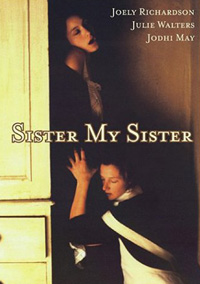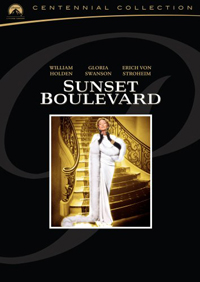The Servant

Not counting the fairly recent 300, the '60s produced my favorite gay films: Basil Dearden’s Victim, Robert Aldrich’s The Killing of Sister George, and particularly Joseph Losey and Harold Pinter's The Servant. The three form a trilogy to my mind: all are British; like the kitchen sink realism of the period, they foreground class in their sexual politics; both The Victim and The Servant feature Dirk Bogarde, the finest of cerebral actors, making you feel every thought his characters have; Losey trained and will always be closely aligned with Robert Aldrich. Although Aldrich was more of a bare-knuckles kind of director, his film shares with the more intellectual Losey an approach to sexual identity and politics that I prefer: as a just-so given, full of suggestion, and with a good deal of nuance.
Compare the matter-of-fact presentation of lesbianism in Sister George -- where the indignities heaped upon its protagonist, June 'George' Buckridge, are more common, a fact of modern existence -- to the more literal minded identity politics of Jonathan Demme’s Philadelphia. In the latter case, oppression becomes a matter of sexual identity, whereas in the former, said identity is just another method those in power might use as a means for subjugation. Not that there's anything wrong with the more particularized morality of Philadelphia in principle (Victim is, in fact, a much better example), but unless one already sympathizes with its gay protagonist, the story remains one about the Other. Aldrich’s film requires no such identification, but is instead a reflection of power itself, irrespective of the particularities of sexual orientation or gender.
Continue ReadingBefore Night Falls

Oh, how I adore Javier Bardem. These past five years have been groundbreaking in his career, but before Eat Pray Love, Vicky Cristina Barcelona, and No Country for Old Men, the Spanish heartthrob had a knack for landing roles which were not as stylish and required a gift for versatility. The roles that came before the year 2000 consisted mainly of two kinds of steamy romances: ones in which he co-starred and slobbered over Penelope Cruz or other leading ladies; and ones, such as The Ages of Lulu or Second Skin, where he played a gay love interest. In Before Night Falls, Bardem plays Reinaldo Arenas, a gay Cuban writer with a "sensitivity for poetry," who later trades in verse for novels. Director Julian Schnabel (Basquiat, The Diving Bell and the Butterfly, [Lou Reed's] Berlin) seems to have a knack for biopic tales of artists, be it literary or fine arts. Directors who stick with the same subject matter in all their films usually fall into two categories: ones who are playing it safe and disappoint; and those who have a natural gift for bringing consistent, yet similar stories to the screen. Schnabel does the latter, and though he has less than six features under his belt, each of his works has an amazing cast of stars who were willing to take risks and play some very controversial roles under his direction. Look for an almost unrecognizable cameo by Sean Penn and one from pre-teen Diego Luna.
The film begins by going over Reinaldo’s childhood in Oriente, a place that is presented as poverty-stricken, yet rich with the wilderness and isolation that would remain a source of inspiration for the rest of his life. His gift for poetry was not only recognized by his teacher, but by everyone who stumbled upon his phrases and single words that were etched into trees. As an adolescent, he moves with his single mother (Olatz López Garmendia) to HolguÃn, where the nightlife and revolutionary energy causes him to run away from home with the hope of joining Castro's rebels. Before long, during college in Havana he is noticed by a group of literary enthusiasts who offer him a job working for the National Library. While roaming the streets he meets Pepe (Andrea Di Stefano), a socialite who brings nothing but trouble and remains his lover for many years, though they see other people. The sexual revolution was sort of a counter-attack to the oppression that Arenas and his fellow countrymen experienced. Homosexuality became a tool to fight back against the revolution that he once held sacred - one that sees artists as a threat and nontraditional behavior of any sort as something that holds back progress. Reinaldo ignores this and continues to enjoy his lifestyle and soon he meets and befriends Jose Lezama Lima, who becomes his mentor. Lima's encouragement and connections lead to Reinaldo being offered help with his first novel that he wishes to get published.
Continue ReadingSister My Sister
 Lately I've been stuck in a cycle of comparability within mediums, mainly in terms of literature and film. History itself is interesting to me for that very reason. Depending on who won or lost a war, for example, we can be given two entirely different perspectives on that war's history. Biographies and biopics do the same, which brings me to the different perspectives in film and theory on the Papin sisters—two French chambermaids in the '30s who carried out an atrocious crime that shocked a nation. Their lives, and the crime in question, has been of interest to both psychoanalysts and social theorists, yet given the facts and testimonies during their trial, each person comes away with a different motive.
Lately I've been stuck in a cycle of comparability within mediums, mainly in terms of literature and film. History itself is interesting to me for that very reason. Depending on who won or lost a war, for example, we can be given two entirely different perspectives on that war's history. Biographies and biopics do the same, which brings me to the different perspectives in film and theory on the Papin sisters—two French chambermaids in the '30s who carried out an atrocious crime that shocked a nation. Their lives, and the crime in question, has been of interest to both psychoanalysts and social theorists, yet given the facts and testimonies during their trial, each person comes away with a different motive.
On one hand you've got doctors and historians approaching the sisters within the context of class, in fact calling their actions a class-crime—no more than two underpaid, often humiliated, servants in a harsh class system who took out their rage on their employer and her daughter by murdering them. This theory touches on the assumption that the two were lovers from a broken home, but only as a side note. They consider the slaying premeditated. The opposing outlook deals almost entirely with their sexual identity, sexual relationship with each other, and their disturbing family life. Here theorists make the claim that the two were mentally disturbed, that there could have been unreported instances of sexual abuse, and that the crime was one of passion, or at the very least of a sexual construct. The two films that I've discovered that chronicle their lives best are Murderous Maids, a French production, and a British production, Sister My Sister.
The Maltese Falcon

Like John Ford & John Wayne or Scorsese & De Niro, John Huston & Humphrey Bogart's work together as director and star will be forever linked in audiences' subconscious. After years of being a happening screenwriter, Huston got his chance to direct his own adaptation of Dashiell Hammett's crime novel, The Maltese Falcon. The film would help make Bogart a leading man, would lead to a 50-year career for Huston, and set the standard for detective films to come.
Like many detective and crime films of the 1940s, The Maltese Falcon is often improperly lumped in with the Film Noir genre. At best, The Maltese Falcon could be deemed a kick-starter to the genre that actually peaked in the post-WWII years. With the exception of a femme fatale or a detective it has little in common stylistically with the best of Film Noir (The Postman Always Rings Twice, Out Of The Past, etc.). That's not to say that the film (and the book) were not hugely influential, they were.
Continue ReadingAce In The Hole

Though it doesn’t revolve around a murder or a heist, Ace in the Hole remains a definitive film noir. Bitter, caustic, and unremittingly dark, it prophesied our age of journalistic madness as it focused on a literal “media circus” developed by a story-hungry press.
In a virtuoso performance that equals his turn in Vincente Minnelli’s The Bad and the Beautiful, Kirk Douglas stars as Chuck Tatum, a down-on-his-heels newsman who desperately takes a job at a tank-town Albuquerque paper. He stumbles on the headline of a lifetime after the owner of a roadside diner is trapped in an abandoned mineshaft while hunting for Indian artifacts. Envisioning a Pulitzer Prize and a return to the big time in New York, Tatum ruthlessly controls the story, befriending the terrified victim (Richard Benedict), romancing his slatternly wife (Jan Sterling), and cynically working local authorities and big-city editors. Then things start to come apart…
Continue ReadingDouble Indemnity

If you know nothing about film noir, start with Double Indemnity. This classic by director Billy Wilder was among the first bona fide pictures in the postwar genre, and it contains all the essential elements – lust, greed, violence, betrayal – that animated this wondrous American style during its great epoch of the 1940s and ‘50s.
Based on a novel by hardboiled fiction forefather James M. Cain, the biting script was co-authored by Wilder and Raymond Chandler, creator of detective Philip Marlowe. The brutal, sleazy tale is recounted (in traditional voiceover style) by canny but weak-willed Los Angeles insurance salesman Walter Neff (Fred MacMurray), who is ensnared by the scheming trollop Phyllis Dietrichson (Barbara Stanwyck). The pair hatch a complicated plot to murder her wealthy husband and collect a large double indemnity insurance policy. But they don’t reckon on the acute intuition of Neff’s friend and co-worker, claims investigator Barton Keyes (Edward G. Robinson), whose “little man” in the pit of his stomach tells him something isn’t quite right.
Continue ReadingDetour (1945)

Film students across the world come to be familiar with Edgar G. Ulmer's Detour because it's one of the first examples of the "noir" genre; it makes clever use of its low budget and it offers a classic, if simplistic, story on how men and women can manipulate each other into horrendous actions. While all of these are the reasons why the film still holds up today, it's also more fun to think of Detour as the 1940s equivalent of Stranger Than Paradise or Clerks. Super low-budget and completely pioneering in its time for depicting human behavior, this is a film that can still prove to people that quality films can be made outside of Hollywood.
The story opens up on a grizzled and paranoid-looking Al Roberts, who staggers into a diner somewhere in the barren remoteness of Southern California, just outside of Los Angeles. He reacts harshly when somebody in the diner plays a particular song on the jukebox and, after apologizing and being nearly kicked out, he drinks his coffee and begins to tell his story over narration.
Continue ReadingOut of the Past

Of that post-WWII generation of male actors who came of age in war flicks but really defined themselves in the Film Noir genre, none was cooler than Robert Mitchum (and that was a group of cool dudes that included Burt Lancaster, Richard Widmark, Sterling Hayden, Robert Ryan, and his co-star here Kirk Douglas). Whether playing a hero or a villain, Mitchum reeked of both danger and manly charm even when he spewed indifference. His career spanned decades with a number of signature roles and important films, but of the Noir period none was better than that of ex-detective turned gas station owner Jeff Bailey in Out of the Past.
Director Jacques Tourneur is more known today for his groundbreaking horror flicks with producer Val Lewton: Cat People, The Leopard Man and I Walked With a Zombie. Though in retrospect those eerie and strange shadowy black n’ white flicks could be called horror noir, making the Frenchman the perfect director to bring his almost Expressionistic approach to a crime mystery in what was then considered a B-genre. Like much gothic horror, Jeff Bailey is a guy haunted by his past, trying to escape from his own mind and hide from his own instincts.
Continue ReadingSunset Blvd.
 There has never been a screenplay quite like Charles Brackett and director Billy Wilder’s screenplay for their 1950 opus Sunset Blvd. It’s a macabre gothic noir comedy about the ghosts of Hollywood past. It’s one of those films, though a first-string classic, where the myths and back-stage stories are just as memorable as the film itself. For a legendary cynic like Wilder it was his ultimate drubbing of the hand that fed him. For star Gloria Swanson it was the ultimate film comeback (ten times more unlikely than, say, Travolta in Pulp Fiction). And for her co-star William Holden it began a decade of big performances in important films that cemented him as a major actor. In a time when the studios controlled their products as well as their own image with an iron fist, it’s shocking that Sunset Blvd. ever got made.
There has never been a screenplay quite like Charles Brackett and director Billy Wilder’s screenplay for their 1950 opus Sunset Blvd. It’s a macabre gothic noir comedy about the ghosts of Hollywood past. It’s one of those films, though a first-string classic, where the myths and back-stage stories are just as memorable as the film itself. For a legendary cynic like Wilder it was his ultimate drubbing of the hand that fed him. For star Gloria Swanson it was the ultimate film comeback (ten times more unlikely than, say, Travolta in Pulp Fiction). And for her co-star William Holden it began a decade of big performances in important films that cemented him as a major actor. In a time when the studios controlled their products as well as their own image with an iron fist, it’s shocking that Sunset Blvd. ever got made.
Narrating from a swimming pool of a rundown mansion, a floating corpse tells his story of how he ended up there. Down-and-out screenwriter Joe Gillis (Holden) can’t land a new assignment and is on the run from debt collectors. With a flat tire he hides his car in the garage of that rundown mansion. Invited in by the home’s butler, Max (Erich von Stroheim), to lend a hand for the funeral of a monkey Joe soon meets the mistress of the house, one-time silent film star, Norma Desmond (Swanson). She lives with only one foot in reality. Her decrepit house is filled with photos and mementos of her former self from her glory days 30 years earlier. Eventually she employs Joe to write her gaudy screenplay that she plans to use as a comeback vehicle. Joe also takes on the role of gigolo, becoming her lover as she keeps him dressed in tuxes and fancy gold watches.
Apocalypse Now

Back in 1979, $31 million, much of it from director Francis Ford Coppola's own pocket, was considered overly indulgent by critics and poo-pooers, as was everything about Apocalypse Now. Many cinefiles were outraged over the vastness of the film and Marlon Brando's big paycheck for his supporting role. And then they were disappointed, calling the film empty and void of ideas or, worse, solutions. But now, decades later, it can be seen for what it is, a big, exciting masterpiece. Coppola was a major filmmaker working at the peak of his powers; the spectacle is as good as it gets, especially in a pre-computer manufactured effects era.
Kinda-sorta based on Joseph Conrad's novel Heart of Darkness, Apocalypse Now opens with a distraught and drunken Captain Willard in a Saigon hotel room battling his demons. We now know from Eleanor Coppola's book on the making of the film and the brilliant documentary Hearts Of Darkness: A Filmmaker's Apocalypse that actor Martin Sheen was actually drunk on the set and fighting his own personal demons which helped lead to his astounding performance (he replaced Harvey Keitel two weeks into shooting). Willard is one of the black-op soldiers brought in to do dirty jobs for his handlers. After getting cleaned up, he is given a new assignment: get a boat crew together, travel up the river (into the heart of darkness), out of Vietnam and into Cambodia, and assassinate a decorated American Colonel, Kurtz (Brando), who, with a ragtag army of followers, has gone AWOL, gone native, and gone quite mad.
Continue Reading




